Complimentary worldwide shipping on orders over $400 · No import tariffs for most countries
Complimentary worldwide shipping on orders over $400 · No import tariffs for most countries
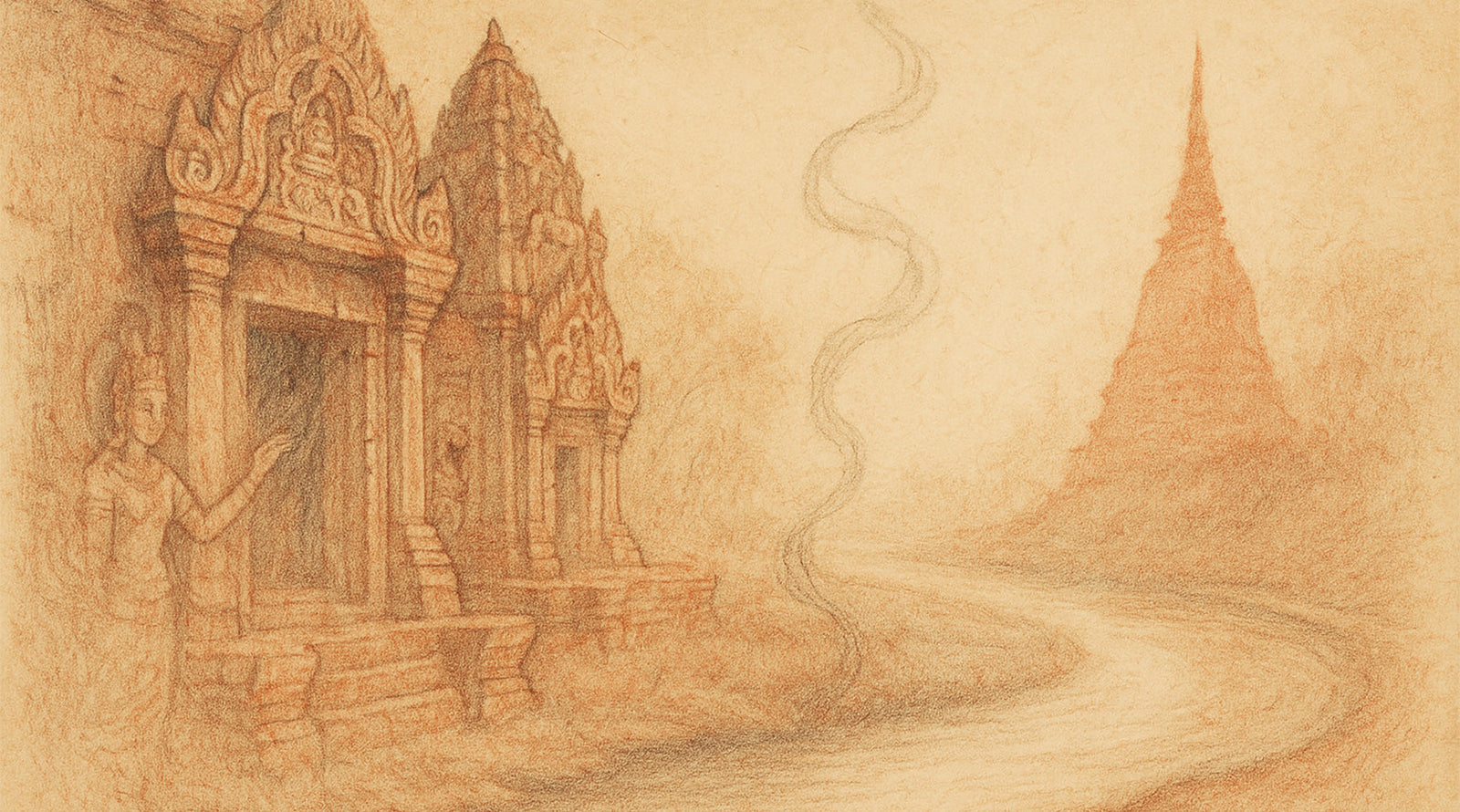
The Shape of a Vanishing Empire
4 min read
Prologue
This past weekend, I travelled to Phnom Penh for an exhibition—three days of light, conversation, and the quiet gravity of shared work. On the long road back to Siem Reap, the sky was bruised with rainlight and the sugar palms stood still in the fields. Somewhere between Kampong Thom and the curve into Kompong Kdei, my thoughts turned inward.
Along the horizon, I saw echoes—not of temples, but of borders. News of recent tensions and skirmishes along the Cambodian–Thai frontier had been circling like monsoon birds—restless, half-heard. And there, in that long stretch of road where time slows, I found myself tracing the lines backward.
What does it mean to inherit the memory of an empire? What does it mean when sacred stones remember differently on either side of a border? The names—Phimai, Lopburi, Sukhothai, Ayutthaya—are not strangers to Angkor. They are part of its long breath.
This article began in that hour of dusk between provinces, as an attempt to listen deeper—not to maps or flags, but to the shape of relinquishment. To what Ayutthaya carried, and what Angkor let go.
Let the light that once bowed at the lintel still shape the way we see.
The Shape of a Vanishing Empire
What Ayutthaya Carried, and What Angkor Let Go
The light that leaves a temple
does not forget
the shape of the door.
—
There are no simple endings in sacred time.
In the hush beneath the forest canopy, the stones still remember—Khmer syllables worn soft by monsoon and flame. What we call the fall of Angkor is not a collapse, but a relinquishing. A slow turning inward. A reorientation of spirit. A redrawing of breath.
From the 9th to the 13th centuries, the Khmer Empire rose like a constellation traced in rice and water. Its centre was Angkor: a labyrinth of temple-cities shaped by cosmic law, by hydraulic vow, by the breath of kings. Angkor Wat. Angkor Thom. Banteay Srei. These were not cities, but mandalas made stone—visions of heaven mirrored on earth. Roads stretched outward to Phimai and Lopburi; its spirit echoed across the Chao Phraya valleys.
But no constellation holds its form forever.
By the twilight of the 12th century, fissures had begun to run beneath the brilliance. The barays and canals that once harnessed the monsoon faltered under drought and deluge. Power slipped from the centre to ambitious peripheries. The devarāja grew more ceremonial than sovereign. And beyond the mountain rim, the Tai had begun their descent.
They came slowly—like mist over ridgeline—Tai-speaking peoples from the southern highlands of what is now China, drifting into the fertile basins of the Chao Phraya. At first, they knelt to the old cosmologies. They borrowed Khmer titles, built in Khmer form, consecrated their rule with Khmer rites. But their breath was new. Their voice carried the dharma.
Not the god-king, but the righteous king.
Not the axis of the cosmos, but the wheel turning toward liberation.
Sukhothai declared its independence in the 13th century, but it was Ayutthaya that would gather the threads of a vanishing empire and weave them into something new. Founded in 1351, cradled by river and tide, Ayutthaya did not overthrow Angkor. It reimagined it. It inhaled its sacred forms and exhaled them in a new cadence. Ayutthaya wore the crown of Angkor—but turned its face to the sea.
By 1431, Ayutthayan forces entered Angkor Thom. It was not conquest but punctuation—an end already long in motion. The Khmer court, rain-worn and exhausted, withdrew to the riverbanks of Phnom Penh. And in the stone galleries of Angkor, the gods looked westward and were still.
Yet in Ayutthaya, the echo remained. The new city carried within it the breath of Khmer artisans, the rhythm of Angkorian ritual, the silhouette of sacred geometry. It is there in the sweep of pediments, in the hush of lotus domes, in the curve of a guardian’s lip. A legacy does not vanish. It transmutes.
To remember is not to preserve—
but to let what endures
shape you from within.
In Isan, the northeast of modern Thailand, the stones still whisper in Khmer. In the village temples, Angkor lives on—in gesture, in offering, in script traced by ordinary hands. The shift from Khmer to Siamese was not erasure. It was a palimpsest. Beneath every new line, the old song remains.
Theravāda softened the fire of the god-king.
Trade supplanted ritual at the axis of power.
Cities grew not from mandala but from harbour and plain.
The wheel turned. But not without sorrow.
For Cambodia, the fall of Angkor became both wound and seed—a time of inward turning, of sacred fragmentation, of shadows before the return of light. For Thailand, Ayutthaya became the genesis of kingship renewed. But without Angkor, it would have risen on different ground.
Stone does not forget its quarry.
Nor does a river forget
the shape of its first bend.
—
Even in silence, the light remembers where it once bowed.
Also in Library
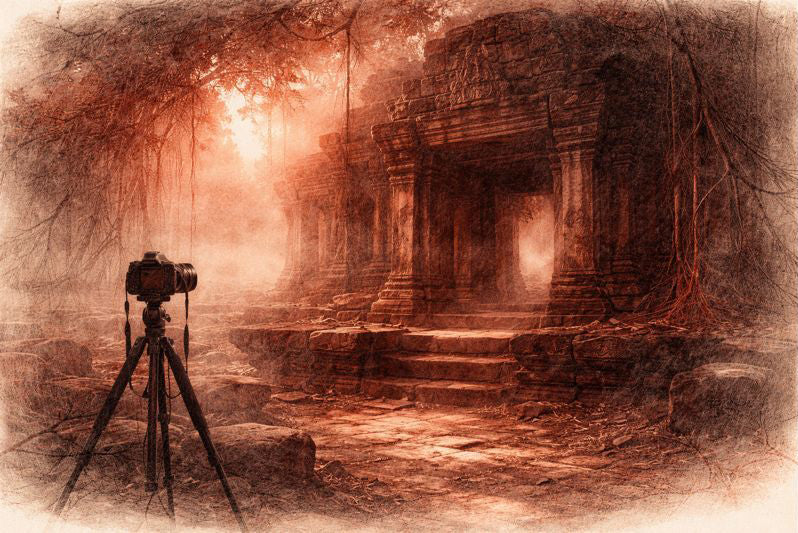
Before the Shutter Falls
3 min read
Before the shutter falls, fear sharpens and doubt measures the cost of waiting. In the quiet hours before dawn, the act of not-yet-beginning becomes a discipline of attention. This essay reflects on patience, restraint, and the quiet mercy that arrives when outcome loosens its hold.
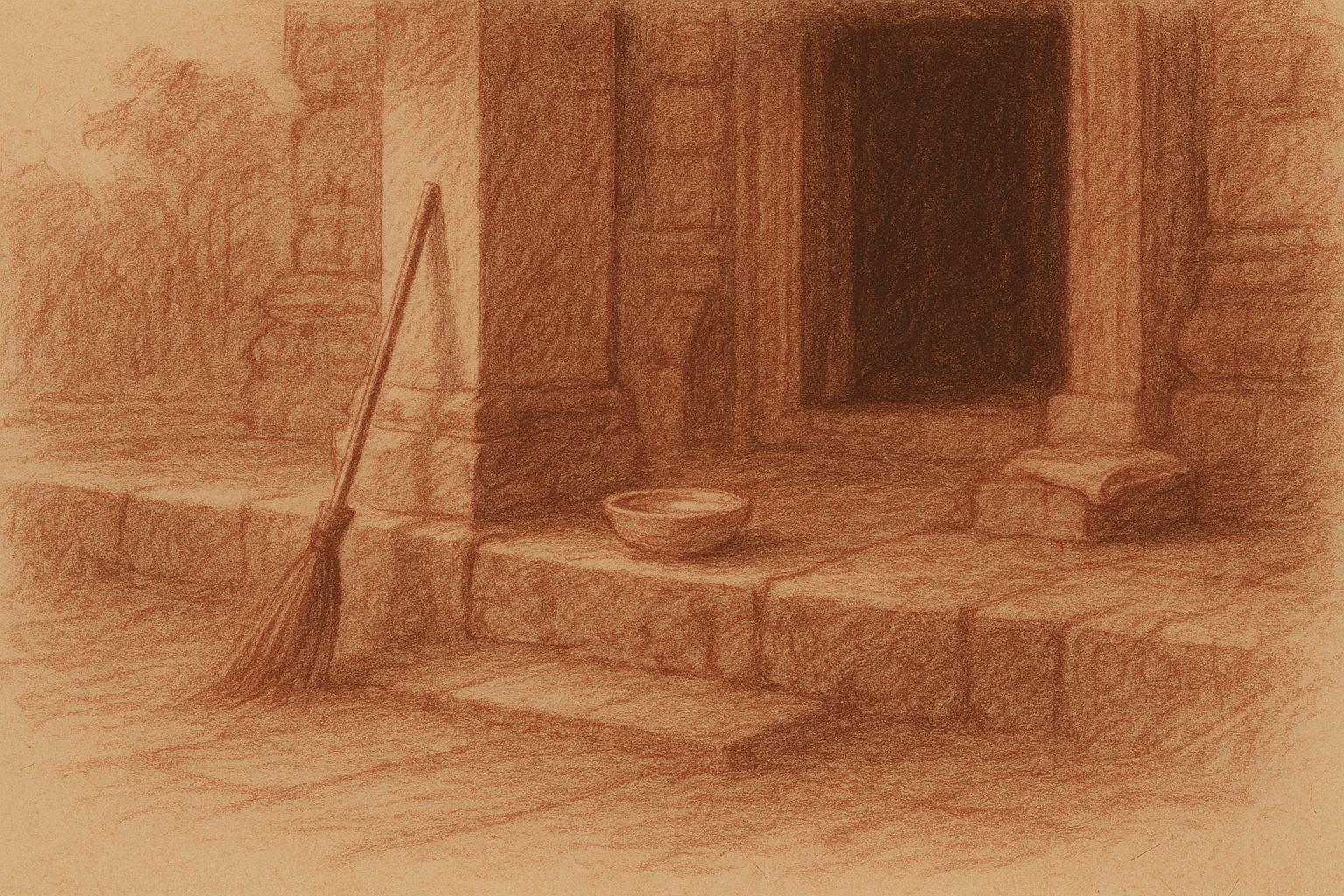
Those Who Keep the Way Open — On the Quiet Guardians of Angkor’s Thresholds
3 min read
Quiet gestures shape the way into Angkor — a swept stone, a refilled bowl, a hand steadying a guardian lion. This essay reflects on the unseen custodians whose daily care keeps the thresholds open, revealing how sacredness endures not through stone alone, but through those who tend its meaning.
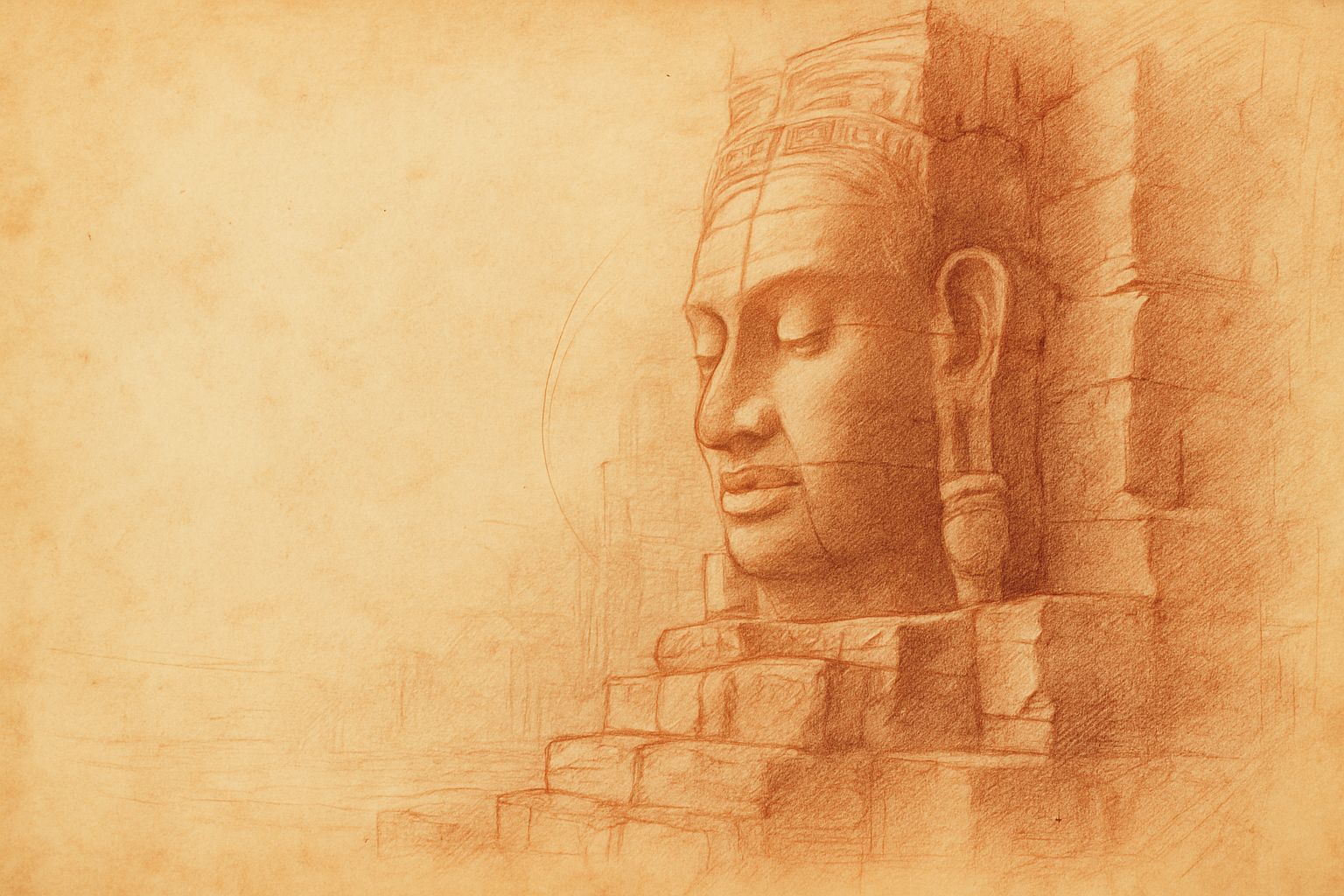
Multiplicity and Mercy — The Face Towers of Jayavarman VII
5 min read
A new vision of kingship rises at the Bayon: serene faces turned to every horizon, shaping a world where authority is expressed as care. Moving through the terraces, one enters a field of steady, compassionate presence — a landscape where stone, light, and time teach through quiet attention.
Join My Studio Journal
Receive occasional letters from my studio in Siem Reap—offering a glimpse into my creative process, early access to new fine art prints, field notes from the temples of Angkor, exhibition announcements, and reflections on beauty, impermanence, and the spirit of place.
No noise. No clutter. Just quiet inspiration, delivered gently.
Subscribe and stay connected to the unfolding story.
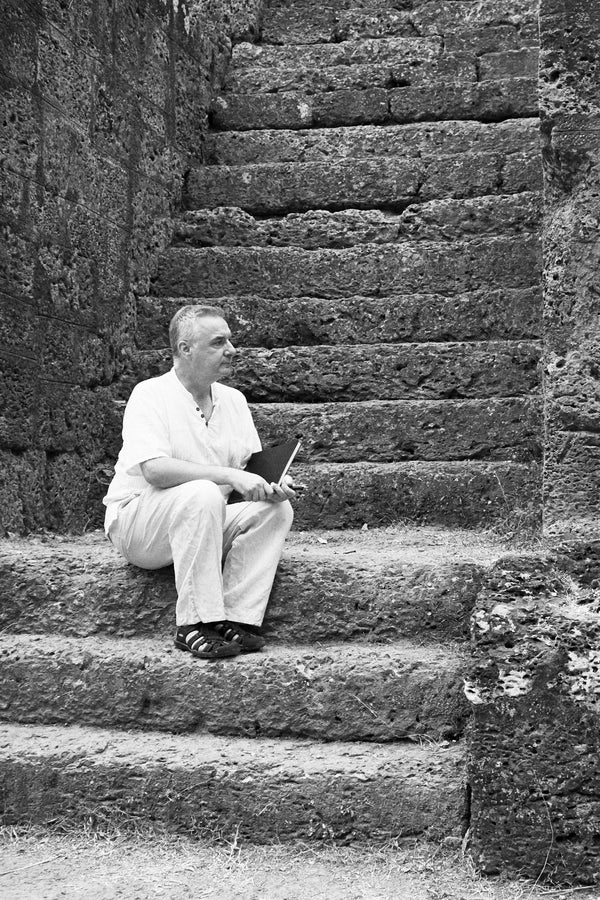
Join My Studio Journal
Receive occasional letters from my studio in Siem Reap—offering a glimpse into my creative process, early access to new fine art prints, field notes from the temples of Angkor, exhibition announcements, and reflections on beauty, impermanence, and the spirit of place.
No noise. No clutter. Just quiet inspiration, delivered gently.
Subscribe and stay connected to the unfolding story.
